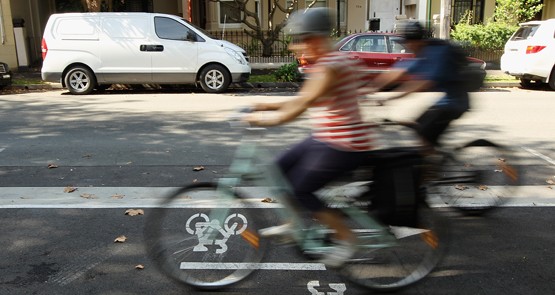
A video recently uploaded to YouTube shows keen Sydney cyclist Cameron Laird being taken down by a car at a roundabout on the genteel streets of Mosman early last Tuesday evening (corner of Bardwell and Belmont). Since Cameron is my nephew, I took the opportunity to find out a bit more.
His bike was damaged, but fortunately he didn’t come off too badly. “I have abrasions to right hip and elbow, not too bad really, but head did hit road very hard, hence ambos took me to hospital for observation,” he told me.
This incident is just one of thousands of low-speed “bingles” that happen all across the country every week. As I noted recently, they’re so minor the police leave it to the insurance companies to sort out.
However when one of the vehicles is a bicycle, the outcome is often far more serious. At the very least, the rider is likely to suffer shock and abrasions — but they can easily be seriously hurt.
In this case the driver was remorseful and behaved well. He’s offered to pay Cameron’s costs and visited him at home next morning.
Cameron tells me the police didn’t attend the scene but the driver voluntarily reported to the police station after the incident and Cameron went in the next day. The driver was duly ticketed.
The amazing thing is the car can be seen approaching on the left in the front camera view; the driver has a clear view of Cameron, who has quite properly “taken the lane”. In fact, it’s clear the car struck him from behind.
I don’t doubt the driver when he lamely says, “Sorry, I didn’t see you, mate”. What’s much harder to fathom is why he didn’t.
I expect many experienced drivers don’t consciously look for other vehicles on the road like a learner constantly does. They rely more on “instinct” (the Type 1 part of the brain) to alert them to possible threats, typically another vehicle.
It might be that a small and comparatively inconspicuous cyclist doesn’t always register. The puzzle in this case though is that Cameron was directly in front of the driver when he was struck.
Cyclists are going to have to share some road space with vehicles for a long time yet, so what can be done about bingles involving a car and a cyclist?
In some cases, better engineering might be the best answer, e.g. perhaps more aggressive traffic calming at the entrance to the roundabout might have saved Cameron’s skin. But it won’t help in all cases. Here are some other possibilities:
- Should motorists be obliged to report to police all crashes involving a bicycle and a motorised vehicle?
- Should police be obliged to have a discussion with a motorist who’s the subject of a complaint by a cyclist even if there’s no prospect of a conviction?
- Should motorists who commit a traffic offence resulting in a cyclist (or any vulnerable road user) crashing be subject to a higher penalty?
- Should collision detection systems like those already available in prestige vehicles be made mandatory on new vehicles?
Cameron’s a roadie, but this crash was a low-speed event; he estimates he was doing about 15 km/h. Even so, he hit his head pretty hard on the road when he went down: “All OK though, but yeah helmet certainly did its job, wouldn’t want to think about what could be if didn’t have helmet on, head really whacked the road hard!”
That doesn’t make the case for making helmets mandatory for every rider, but it suggests wearing a properly fitted helmet is a smart choice for cyclists who mix with Sydney’s traffic.








Crikey is committed to hosting lively discussions. Help us keep the conversation useful, interesting and welcoming. We aim to publish comments quickly in the interest of promoting robust conversation, but we’re a small team and we deploy filters to protect against legal risk. Occasionally your comment may be held up while we review, but we’re working as fast as we can to keep the conversation rolling.
The Crikey comment section is members-only content. Please subscribe to leave a comment.
The Crikey comment section is members-only content. Please login to leave a comment.